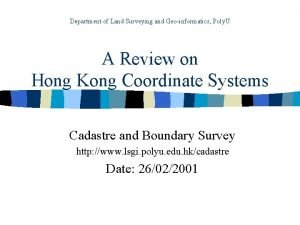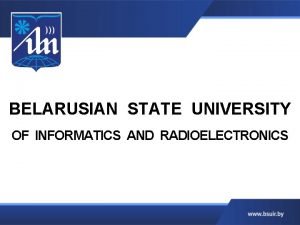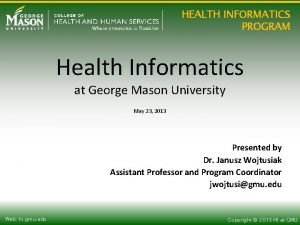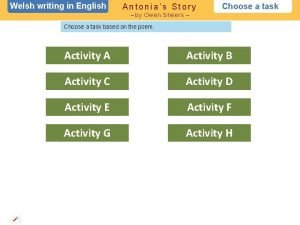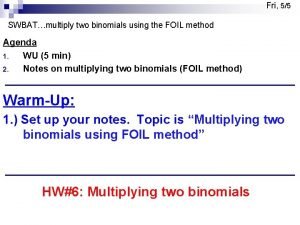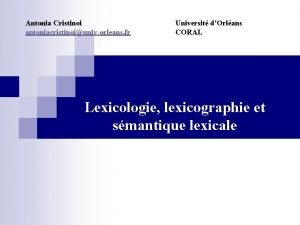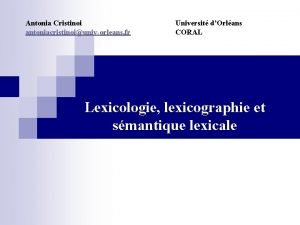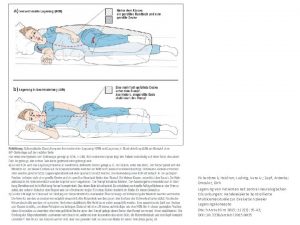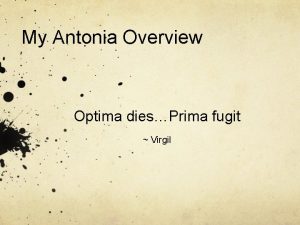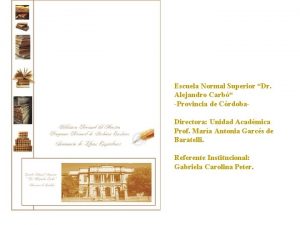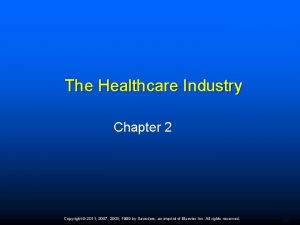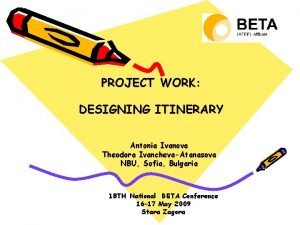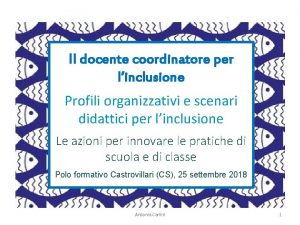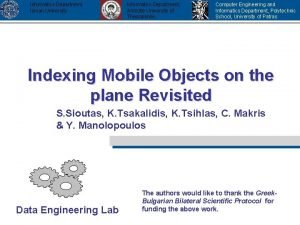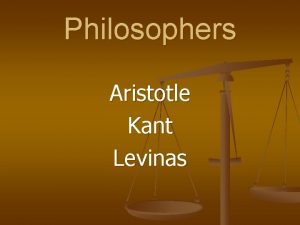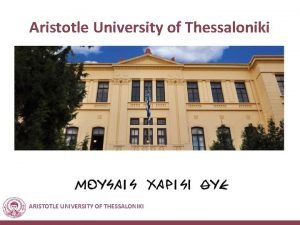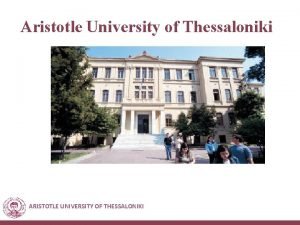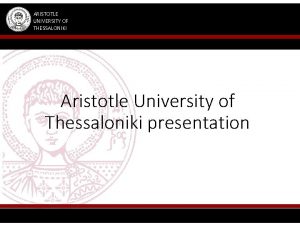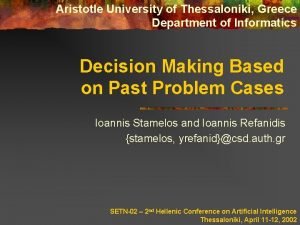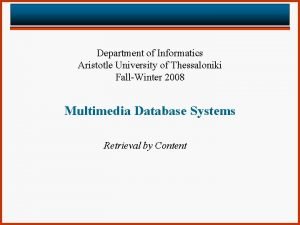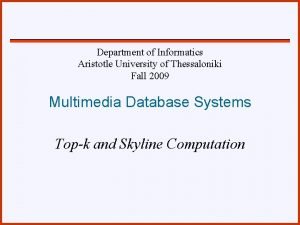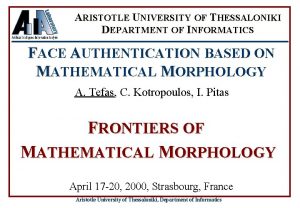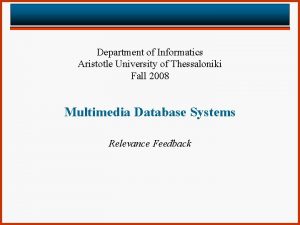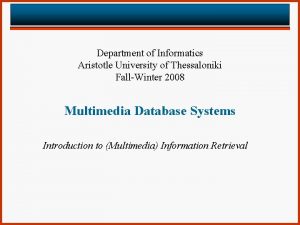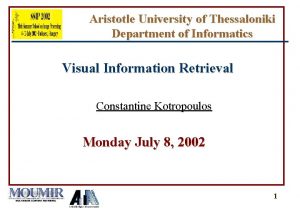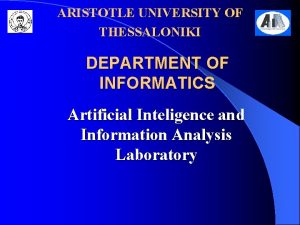Antonia Gogoglou Department of Informatics Aristotle University of















- Slides: 15

Antonia Gogoglou Department of Informatics Aristotle University of Thessaloniki Antonis Sidiropoulos Department of Information Technology, Alexander Technological Institute of Thessaloniki 07/13/2016 A SCIENTIST ’SIMPACT OVERTIME : THE PREDICTIVE POWER OF CLUSTERING WITH PEERS Dimitris Katsaros Department of Electrical Engineering and Computer Engineering, University of Thessaly Yannis Manolopoulos Department of Informatics Aristotle University of Thessaloniki Gogoglou, Sidiropoulos, Katsaros, Manolopoulos IDEAS 2016 1

• A large pool of data is available online(Google Scholar, Microsoft Academic Search, Scopus, Web of Science, etc. ). • Two important questions have yet to be answered: • “How does the career of a scientist in terms of his/her impact on the community progress over time? ” • “Are there early signs of scientific potential? ” Gogoglou, Sidiropoulos, Katsaros, Manolopoulos IDEAS 2016 • More than 100 indices exist to evaluate scientific work at author, publication or journal level. 07/13/2016 Scientometrics: a plethora of metrics- Open Issues 2

• Introduce the problem of consistently grouping together peers over time and maintain a fair comparison basis. • Develop a methodology for quantifying and visualizing individual scientists’ evolution. • Compare proposed methods with peer-review to assess effectiveness. Gogoglou, Sidiropoulos, Katsaros, Manolopoulos IDEAS 2016 • Apply a macroscopic approach to identify patterns in scientific output evolution and observe early signs of academic potential. 07/13/2016 Our goals: 3

Gogoglou, Sidiropoulos, Katsaros, Manolopoulos IDEAS 2016 • Full citation records retrieved from MAS for 30000 scientists of the Computer Science field with over 9 million papers and 38 million citations. In this dataset we have identified 22 SIGMOD award winners and 62 Turing award winners. 07/13/2016 Data set description: Table 1: Cardinality of datasets. 4

Challenges: the appropriate clustering algorithm • Dynamic clustering algorithms (DBSCAN, Learning Vector Quantization, etc. ) provide different optimal number of clusters for each dataset. • We have adapted a Self-Organizing Map (SOM) approach to produce a specified number of clusters for each “snapshot”. Gogoglou, Sidiropoulos, Katsaros, Manolopoulos IDEAS 2016 • Diverse datasets to be assigned to clusters automatically ranked to allow temporal comparisons. 07/13/2016 • Feature selection: h-index, PI/papers and total citations (C). 5

Challenges: the appropriate number of clusters For different numbers of clusters we evaluated the silhouette, “precision” and “recall” and opted for 4 clusters to achieve better performance as well as meaningful segmentation. Gogoglou, Sidiropoulos, Katsaros, Manolopoulos IDEAS 2016 For each feature and each distinct cluster sum. Min, sum. Mean and sum. Max are calculated and used to rank the clusters based on quality of members. 07/13/2016 • Two-phase approach: 6

Table 2: Scores for the three evaluation metrics. Gogoglou, Sidiropoulos, Katsaros, Manolopoulos IDEAS 2016 07/13/2016 Scores for different cluster numbers 7

Gogoglou, Sidiropoulos, Katsaros, Manolopoulos IDEAS 2016 Cluster 1(high impact): red Cluster 2(moderate-high impact): green Cluster 3(moderate-low impact): blue Cluster 4(low impact): cyan 07/13/2016 Clustering result visualization: Figure 1: Authors with academic age 15 -20 years in the year 2013 clustered in 4 groups projected on the Principal Component space. 8

Gogoglou, Sidiropoulos, Katsaros, Manolopoulos IDEAS 2016 07/13/2016 Time evolution of clusters (1): Figure 2: Cluster membership of all authors in the set since they first appear in a cluster. 9

Figure 3: Cluster membership of authors who have been clustered more than 4 times in a lower impact cluster than the best cluster membership they have ever scored. Figure 4: Cluster membership of scientists that managed to progressively increase their score in all 3 bibliometric indices (C, h, PI) thus improving their cluster memberships. Gogoglou, Sidiropoulos, Katsaros, Manolopoulos IDEAS 2016 07/13/2016 Time evolution of clusters (2): 10

Table 3: Cluster membership for scientists that have won the ACM SIGMOD’s E. F. Codd award. Gogoglou, Sidiropoulos, Katsaros, Manolopoulos IDEAS 2016 • Almost all of the awarded scientists have been clustered to the high impact cluster (cluster 4) from the beginning of their career. • Their scores according to the 3 bibliometric indexes may not be significantly high as absolute values (cumulative nature of indexes), but can prove distinguishing compared to the analogous ones of their academic peers. 07/13/2016 Comparison with award winners (1): 11

Gogoglou, Sidiropoulos, Katsaros, Manolopoulos IDEAS 2016 07/13/2016 Comparison with award winners (2): Table 4: Cluster membership for scientists that have won the Turing award. 12

• lead to valuable characterization of scientific output • reveal early signs of increased scientific potential • assist promotions and funding decisions (complementary to peer review) • The established dimensionality reduction and clustering algorithms with the addition of proposed heuristics and metrics allow for an automated and unified over time ranking to be achieved. Gogoglou, Sidiropoulos, Katsaros, Manolopoulos IDEAS 2016 • A unified framework that incorporates combination of features and the time parameter as well as the concept of peer comparison can: 07/13/2016 Conclusions: 13

• Compare clustering results with other complex networks techniques to identify influential nodes (i. e. scientists) in a large network based on automated and unified methodologies that can be applied across diverse datasets. • Explore other community detection and ranking methods through analyzing networks of scientists and contrast those with the clustering results to discover similarities and differences. Gogoglou, Sidiropoulos, Katsaros, Manolopoulos IDEAS 2016 • Extend our analysis to more award winning groups and other distinguished groups to evaluate the distinguishing power of our approach and identify different patterns in award giving. 07/13/2016 Future work: 14

Gogoglou, Sidiropoulos, Katsaros, Manolopoulos IDEAS 2016 07/13/2016 Thank you for your attention! 15
 Hk 1980 grid coordinate system
Hk 1980 grid coordinate system Belarusian university of informatics and radioelectronics
Belarusian university of informatics and radioelectronics Health informatics george mason
Health informatics george mason Antonia's story poem
Antonia's story poem Fri55
Fri55 Antonia cristinoi
Antonia cristinoi Antonia cristinoi
Antonia cristinoi Andrea dressler
Andrea dressler Optima dies prima fugit my antonia
Optima dies prima fugit my antonia Escuela normal superior dr alejandro carbó
Escuela normal superior dr alejandro carbó Antonia novello
Antonia novello Antonia nicol
Antonia nicol Antonia atanasova
Antonia atanasova Antonia stavrakis
Antonia stavrakis Antonia carlini
Antonia carlini Antonia brinkers
Antonia brinkers
